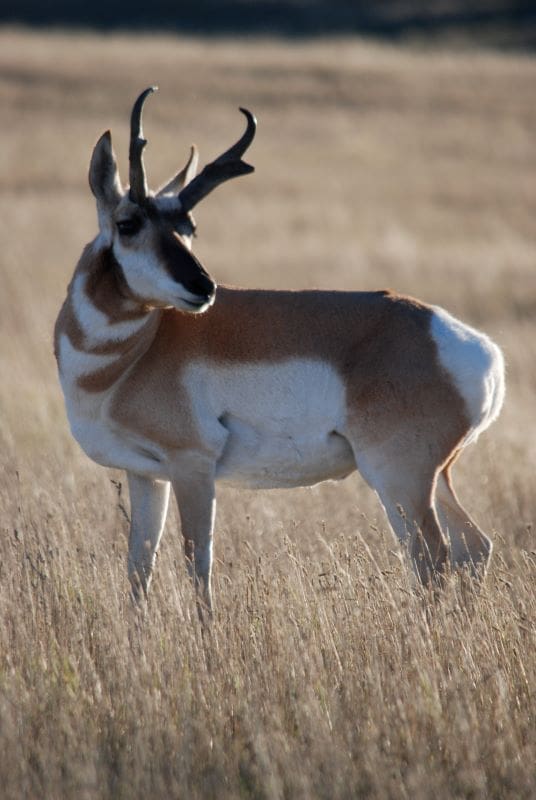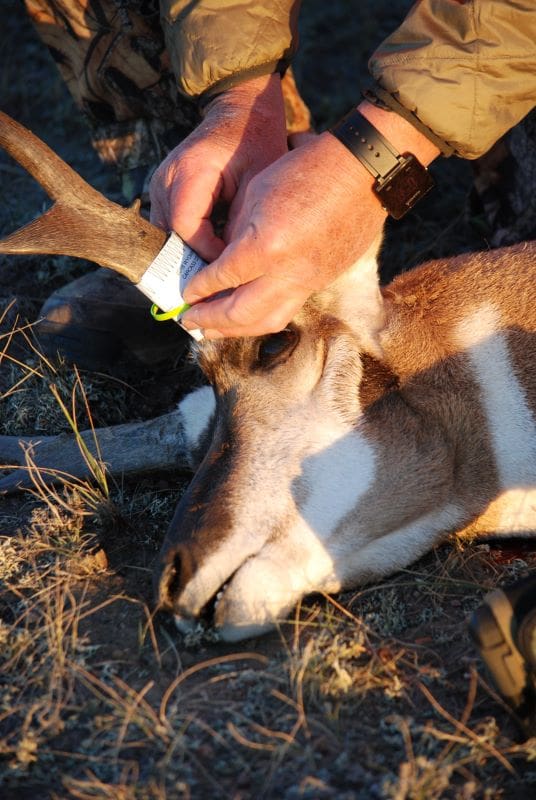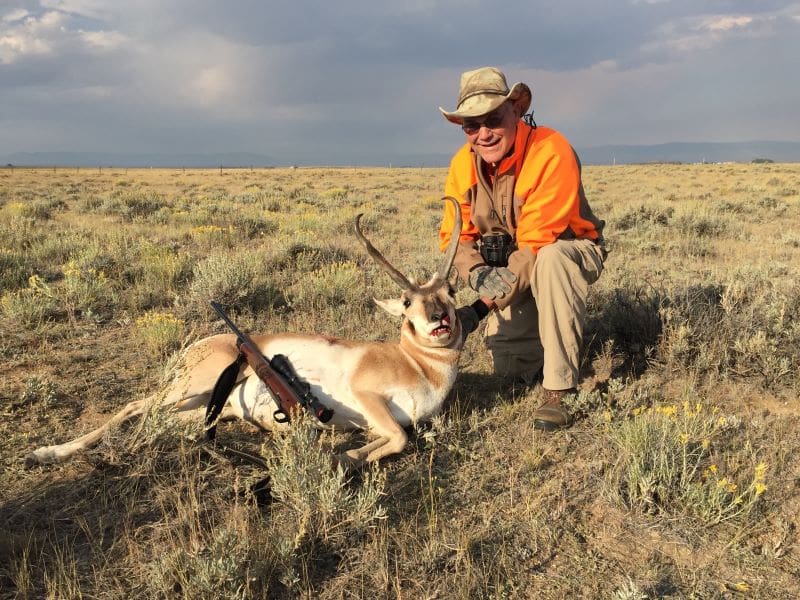Wildlife biologists once claimed there was likely more antelope than people in Wyoming. The least populated state in the United States with just over half a million residents, Wyoming’s booming antelope population was calculated to be close to 500,000 when it peaked seven or eight years ago. Although the Cowboy State’s antelope population has crashed since then, it remains the best place to harvest a speed goat. For many years, the non-resident success rate was near 100%.
“Seven or eight years ago, the antelope population was estimated at 437,000,” said Grant Frost Wyoming Gamer & Fish Big Game Biologist. Chances are good that it was much higher than that. “Since then, the population has declined due to a combination of things,” said Frost. “Drought plus a series of severe winters and the fact that some of the key migration corridors have been blocked have all contributed to the decline.” Researchers estimate that the state’s antelope population has plummeted to 327,000. Despite that, Wyoming has twice as many antelope than any other state and remains the best place to check an antelope off your bucket list.

Drawing a non-resident tag to hunt antelope is not as easy as it once was. Population declines have required game managers to cut back on tag quotas across the state. A recent cutback on the number of non-resident tags from 20% to 10% of the allotted tags has hurt your chances of drawing a tag, but the odds are still better than in other states. After five consecutive years of drawing a tag as a resident, I’ve not drawn one in the last two years as a non-resident. Purchasing preference points can increase your odds of success in future draws. Hopefully, antelope numbers will rebound again, so more permits are available.
Biologist Grant Frost said that antelope and other big game populations were hit particularly hard in the southwest and central part of the state by severe winters in 2022-2023. A mysterious disease severely affected the Sublette herd in the western 1/3 of the state. “The Laramie Region has the largest number of antelope, and fairly good numbers of antelope can be found there,” said Frost. “It may take four or five years, depending on a variety of conditions, for the herd to rebound to previous levels. A lot depends on whether a unit is being managed for recreational hunting or is a specialized unit targeted at older bucks. These specialized areas have the genetics and potential to grow quality animals, but it takes the right combination of factors. On the bright side, 2023-2024 was a mild winter. The southeast region has been very dry. We’ll know more come August.”
Archery hunters can get after antelope as early as August 15. The most common way to hunt archery antelope is by sitting on a water hole or stalking using a decoy. A lightweight silhouette decoy, like the one made by Ultimate Predator Gear (wwww.ulitmatepredatorgear.com; 719-800-1492), attaches to your bow or gun so you can stalk up to curious bucks. Sitting at a water hole takes perseverance, patience, and a battery-powered fan. Conditions can be sweltering in late summer, but it’s a proven method.

Gun season for antelope in Wyoming generally starts about mid-September. The first few days of the season are prime for hunters lucky enough to draw a tag, who have put in time scouting to locate a few good bucks and spent some range time to be able to make the shot when the opportunity arises. Bucks that haven’t wised up yet are easy marks. Once they’re hunted for a few days, they become more and more challenging to get reasonably close to. A second peak occurs in early October when the rut peaks. Bucks throw caution to the wind then and cover a lot of ground looking or does. I’ve been amazed at how dumb they are when love is on their mind.
When hunting antelope with a firearm, you can stay put and wait for the animals to come to you or spot a trophy at a distance and stalk into shooting range. Both methods are productive. In areas where antelope are abundant, sitting and glassing can be a proven technique if you know the travel routes antelope are using. A carefully planned stalk can be rewarding in areas where antelope are scarce or more scattered, and the terrain permits a stealthy approach.
My friend Dave Buskirk and I drew Wyoming antelope tags a few years ago on the Laramie River unit. I’d hunted the unit several times and was familiar with the topography and animal movements. Dave and I had applied as a party for the tags, but once successful, we forgot to apply together for access permits. I drew one; Dave didn’t. We weren’t sure Dave could hunt the Hunter Management Unit I had an access permit for, so we looked for an alternative.

We found several good bucks on BLM land that I was sure we could hunt and be successful on, but as an afterthought, we decided to stop by the ranch I had permission to hunt to see if Dave could get permission. The rancher and his wife greeted us and said they could give Dave permission to hunt. Turns out Dave could start hunting on Saturday on the rancher’s permit, and I had to wait until Monday! On my permit, I wasn’t allowed to scout until the day of my hunt, but we could scout on the rancher’s access permit. Dave and I found several respectable bucks and were excited about our chances.
One question Dave had was, “What’s the weather going to be like?” which is a loaded question.
I responded, “It’s going to be cold in the morning and hot in the afternoon.” Even in September, it can get rather chilly at 7,000 feet, so you must dress accordingly.
Whether sitting or stalking, a garment like ScentLok Technologies BE:1 Phantom Pullover is is a great early season next to skin, lightweight top, and the Mossy Oak Terra Gila camo pattern blends perfectly with prairie sagebrush. Although antelope rely heavily on their eyesight to survive, the cutting-edge Carbon Alloy® technology used in the BE:1 Phantom Pullover adsorb odors and makes you virtually undetectable to antelope that might wind you. Crafted from a breathable and quick-drying fabric, this pullover offers exceptional comfort and is ideal for early-to-mid-season antelope hunting. Add the matching BE:1 Phantom Pant in Mossy Oak Terra Gila to become an antelope ninja. Equipped with a DWR treatment, the BE:1 Phantom Pant repels water and other liquids to help you stay in the field longer. The four-way stretch fabric offers maximum flexibility and ensures exceptional comfort during extended periods of wear. Carbon Alloy® and Silver Alloy™ technology in the pants helps adsorb and prohibit odors, making you virtually undetectable to your prey. The breathable and quick-drying fabric keeps you comfortable in any weather so that you can focus on the hunt.
If you need even more warmth the Savanna Aero Crosshair Jacket in Mossy Oak Terra Outland is another option. Built to conquer the special demands and challenges of the antelope season, the ScentLok Savanna Aero Crosshair Jacket delivers critical comfort, scent control, concealment, and utility. Advanced, lightweight fabrics with built-in moisture-wicking prevent overheating while keeping hunters cool and dry. Get closer with proven-deadly Carbon Alloy® Technology, yielding maximum odor adsorption with additional antimicrobial treatment for odor prevention.
If it gets downright frosty, you can add a BE:1 Reactor Heated Vest. This versatile vest offers four levels of on-demand warmth to ensure you stay cozy on the stand. Its Thinsulate insulation provides warmth without the bulk, making it easy to layer with other garments.

Dave and I accessed the ranch via the north gate. It was still dark, so we decided to stop only 100 yards past the gate and wait for daylight. It wasn’t long before we started to make out shapes and silhouettes, even though the sun was still below the horizon.
We sat in the dark when Dave said, “Wouldn’t it be cool if a buck just walked right over the hill to us?”
I laughed and said, “It’s not usually that easy.” I turned my head a saw two does and a good buck that were going to cross the road 150 yards from us. The buck stopped on the side of the road to scrap.
We looked at each other and shook our heads. “That’s a really nice buck if you want ‘em,” I said. Dave slipped out of the passenger side door as the buck walked to the other side of the road. He dropped him in his tracks. We both walked over to admire the buck.
“Well, that was easy,” Dave laughed. “You kind of got cheated on that one, but we couldn’t pass that one up,” I said as Dave grasped the buck’s thick horns. We were both shivering. “Let’s get back in the truck and wait until the sun warms things up before we gut him.” The truck thermometer read 25 degrees. Later that day, it touched 80.
Two days later, it was my turn. We accessed the property at the opposite end of the ranch. It was a mile walk to a corner where the ranch we were on intersected another. We sat about 300 yards from the corner and waited for daylight. It was cold, but as cold as the previous morning.
When it got light, Dave and I started glassing. We could see 150 antelope in our field of vision. None of them appeared to be shooters. We watched as they began a steady migration to the other ranch, pushed by hunters and vehicles. Antelope streamed by and traded between the two ranches. We spotted numerous bucks, but none that really stood out. Suddenly, we spotted horns above the rest of the herd. The buck had extremely tall horns and was, without question, a shooter, but he was slowly walking back onto the other ranch.
“He’ll be back,” I said. The ranch the antelope were headed to was heavily grazed. The ranch we were hunting had thigh-high sagebrush and thick clumps of green grass. It was only a matter of time. The antelope had been feeding all night, but they’d get hungry again.
At one point, we saw a huge dust cloud in the distance, almost like a tornado. We watched as the cloud got closer and closer until it materialized into a thundering herd of close to 50 antelope. The herd stopped 500 yards distant, and as the dust settled, we could glass the entire herd. The wasn’t a good buck among them.
Probably two hours later, I turned to see a small buck crossing the fence back onto the ranch we were hunting. The big boy was trailing him.
“There he is!” I whispered to Dave. Dave instantly threw up his Leica 10 x 42 rangefinder/binoculars and announced, “He’s 275 yards.”
“Should I shoot?” I queried.
“You’re not going to kill ‘em if you don’t!” came Dave’s coy reply.

I adjusted the Primos Monopod Trigger Stick but quickly told Dave to set up his tripod Trigger Stick instead. I steadied the Remington 700 BDL-DM 30.06, leveled the crosshairs on the Leupold scope on the top of the buck’s shoulder, and squeezed the trigger.
“You dropped him!” Dave exclaimed as he watched the scene through the binoculars.
Hunting antelope in Wyoming is not what it was just a few short years ago, but it’s still the best in the country. There are fewer antelope and fewer tags available. Start applying and buying preference points; eventually, you can scratch “antelope” off your bucket list.
